Gege Wen
Learning Pore-scale Multi-phase Flow from Experimental Data with Graph Neural Network
Nov 21, 2024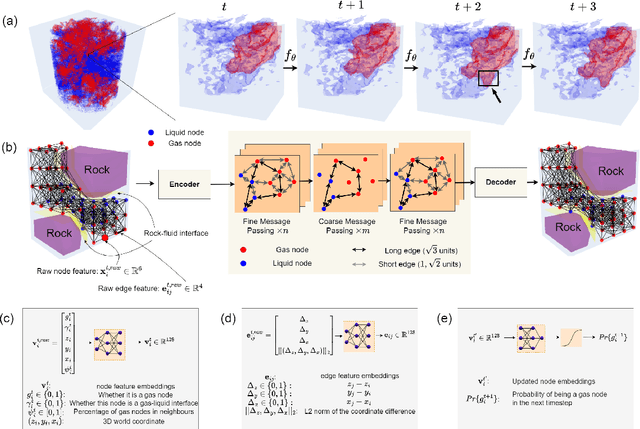


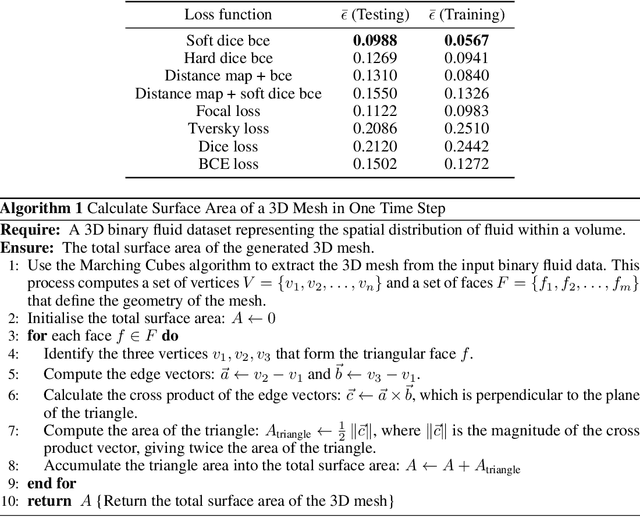
Abstract:Understanding the process of multiphase fluid flow through porous media is crucial for many climate change mitigation technologies, including CO$_2$ geological storage, hydrogen storage, and fuel cells. However, current numerical models are often incapable of accurately capturing the complex pore-scale physics observed in experiments. In this study, we address this challenge using a graph neural network-based approach and directly learn pore-scale fluid flow using micro-CT experimental data. We propose a Long-Short-Edge MeshGraphNet (LSE-MGN) that predicts the state of each node in the pore space at each time step. During inference, given an initial state, the model can autoregressively predict the evolution of the multiphase flow process over time. This approach successfully captures the physics from the high-resolution experimental data while maintaining computational efficiency, providing a promising direction for accurate and efficient pore-scale modeling of complex multiphase fluid flow dynamics.
Learning CO$_2$ plume migration in faulted reservoirs with Graph Neural Networks
Jun 16, 2023



Abstract:Deep-learning-based surrogate models provide an efficient complement to numerical simulations for subsurface flow problems such as CO$_2$ geological storage. Accurately capturing the impact of faults on CO$_2$ plume migration remains a challenge for many existing deep learning surrogate models based on Convolutional Neural Networks (CNNs) or Neural Operators. We address this challenge with a graph-based neural model leveraging recent developments in the field of Graph Neural Networks (GNNs). Our model combines graph-based convolution Long-Short-Term-Memory (GConvLSTM) with a one-step GNN model, MeshGraphNet (MGN), to operate on complex unstructured meshes and limit temporal error accumulation. We demonstrate that our approach can accurately predict the temporal evolution of gas saturation and pore pressure in a synthetic reservoir with impermeable faults. Our results exhibit a better accuracy and a reduced temporal error accumulation compared to the standard MGN model. We also show the excellent generalizability of our algorithm to mesh configurations, boundary conditions, and heterogeneous permeability fields not included in the training set. This work highlights the potential of GNN-based methods to accurately and rapidly model subsurface flow with complex faults and fractures.
Optimizing Carbon Storage Operations for Long-Term Safety
Apr 19, 2023Abstract:To combat global warming and mitigate the risks associated with climate change, carbon capture and storage (CCS) has emerged as a crucial technology. However, safely sequestering CO2 in geological formations for long-term storage presents several challenges. In this study, we address these issues by modeling the decision-making process for carbon storage operations as a partially observable Markov decision process (POMDP). We solve the POMDP using belief state planning to optimize injector and monitoring well locations, with the goal of maximizing stored CO2 while maintaining safety. Empirical results in simulation demonstrate that our approach is effective in ensuring safe long-term carbon storage operations. We showcase the flexibility of our approach by introducing three different monitoring strategies and examining their impact on decision quality. Additionally, we introduce a neural network surrogate model for the POMDP decision-making process to handle the complex dynamics of the multi-phase flow. We also investigate the effects of different fidelity levels of the surrogate model on decision qualities.
Proceedings of AAAI 2022 Fall Symposium: The Role of AI in Responding to Climate Challenges
Jan 06, 2023Abstract:Climate change is one of the most pressing challenges of our time, requiring rapid action across society. As artificial intelligence tools (AI) are rapidly deployed, it is therefore crucial to understand how they will impact climate action. On the one hand, AI can support applications in climate change mitigation (reducing or preventing greenhouse gas emissions), adaptation (preparing for the effects of a changing climate), and climate science. These applications have implications in areas ranging as widely as energy, agriculture, and finance. At the same time, AI is used in many ways that hinder climate action (e.g., by accelerating the use of greenhouse gas-emitting fossil fuels). In addition, AI technologies have a carbon and energy footprint themselves. This symposium brought together participants from across academia, industry, government, and civil society to explore these intersections of AI with climate change, as well as how each of these sectors can contribute to solutions.
Accelerating Carbon Capture and Storage Modeling using Fourier Neural Operators
Oct 31, 2022Abstract:Carbon capture and storage (CCS) is an important strategy for reducing carbon dioxide emissions and mitigating climate change. We consider the storage aspect of CCS, which involves injecting carbon dioxide into underground reservoirs. This requires accurate and high-resolution predictions of carbon dioxide plume migration and reservoir pressure buildup. However, such modeling is challenging at scale due to the high computational costs of existing numerical methods. We introduce a novel machine learning approach for four-dimensional spatial-temporal modeling, which speeds up predictions nearly 700,000 times compared to existing methods. It provides highly accurate predictions under diverse reservoir conditions, geological heterogeneity, and injection schemes. Our framework, Nested Fourier Neural Operator (FNO), learns the solution operator for the family of partial differential equations governing the carbon dioxide-water multiphase flow. It uses a hierarchy of FNO models to produce outputs at different refinement levels. Thus, our approach enables unprecedented real-time high-resolution modeling for carbon dioxide storage.
U-FNO -- an enhanced Fourier neural operator based-deep learning model for multiphase flow
Sep 17, 2021



Abstract:Numerical simulation of multiphase flow in porous media is essential for many geoscience applications. Data-driven machine learning methods provide faster alternatives to traditional simulators by training neural network models with numerical simulation data mappings. Here we present U-FNO, a novel neural network architecture for solving multiphase flow problems with superior speed, accuracy, and data efficiency. U-FNO is designed based on the newly proposed Fourier neural operator (FNO) that learns an infinite-dimensional integral kernel in the Fourier space, which has shown excellent performance for single-phase flows. Here we extend the FNO-based architecture to a CO2-water multiphase problem, and proposes the U-FNO architecture to enhance the prediction accuracy in multiphase flow systems. Through a systematic comparison among a CNN benchmark and three types of FNO variations, we show that the U-FNO architecture has the advantages of both the traditional CNN and original FNO, providing significantly more accurate and efficient performance than previous architectures. The trained U-FNO predicts gas saturation and pressure buildup with a 6*10e4 times speed-up compared to traditional numerical simulators while maintaining similar accuracy. The trained models can act as a general-purpose simulator alternative for 2D-radial CO2 injection problems with wide ranges of permeability and porosity heterogeneity, anisotropy, reservoir conditions, injection configurations, flow rates, and multiphase flow properties.
CCSNet: a deep learning modeling suite for CO$_2$ storage
Apr 05, 2021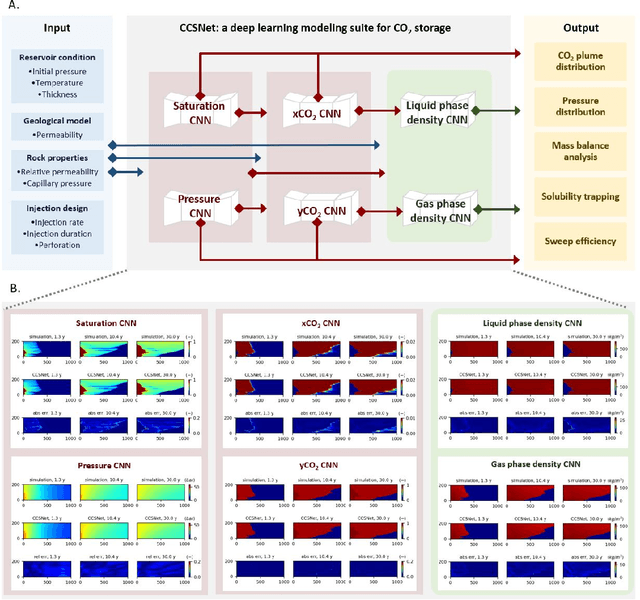
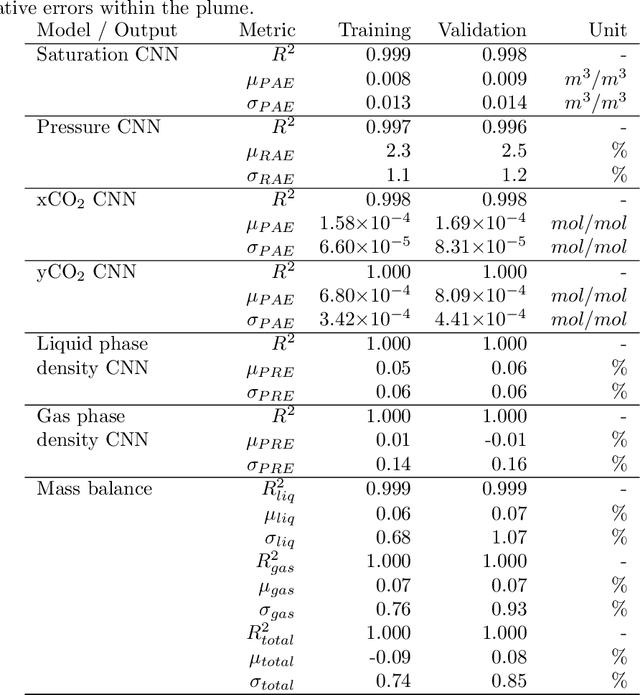
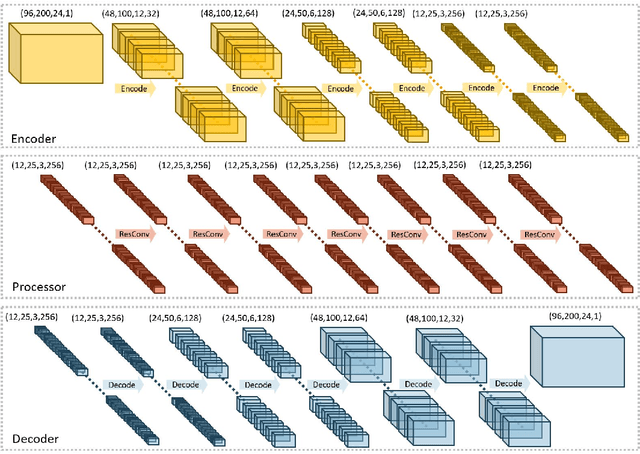
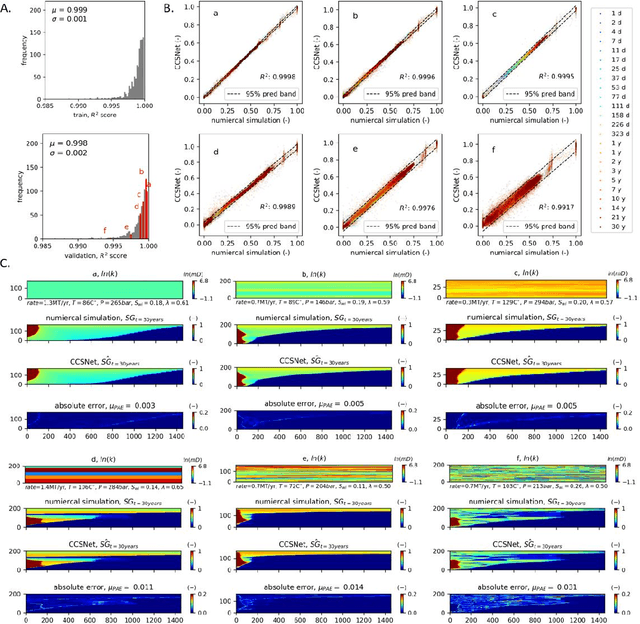
Abstract:Numerical simulation is an essential tool for many applications involving subsurface flow and transport, yet often suffers from computational challenges due to the multi-physics nature, highly non-linear governing equations, inherent parameter uncertainties, and the need for high spatial resolutions to capture multi-scale heterogeneity. We developed CCSNet, a general-purpose deep-learning modeling suite that can act as an alternative to conventional numerical simulators for carbon capture and storage (CCS) problems where CO$_2$ is injected into saline aquifers in 2d-radial systems. CCSNet consists of a sequence of deep learning models producing all the outputs that a numerical simulator typically provides, including saturation distributions, pressure buildup, dry-out, fluid densities, mass balance, solubility trapping, and sweep efficiency. The results are 10$^3$ to 10$^4$ times faster than conventional numerical simulators. As an application of CCSNet illustrating the value of its high computational efficiency, we developed rigorous estimation techniques for the sweep efficiency and solubility trapping.
Multiphase flow prediction with deep neural networks
Oct 21, 2019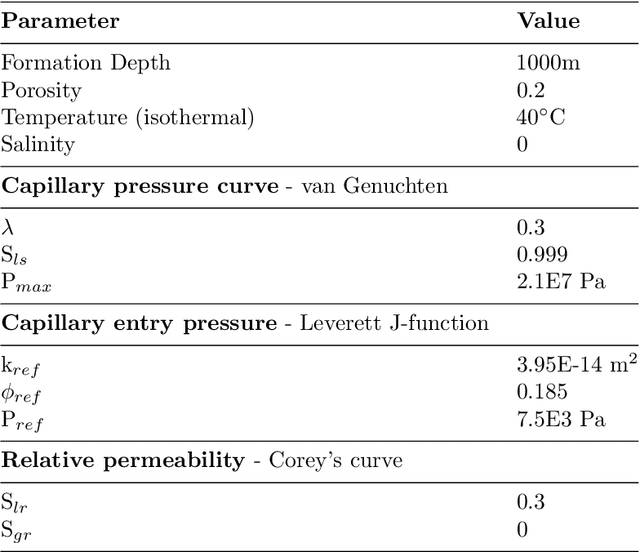
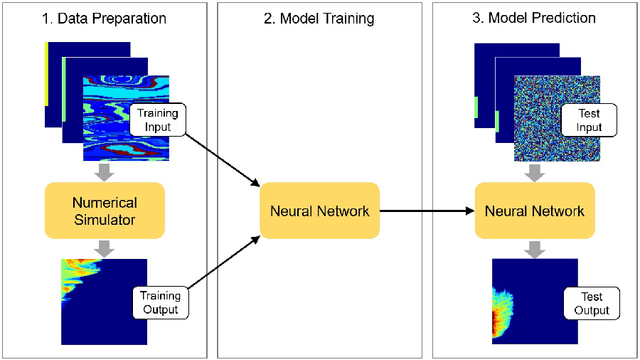


Abstract:This paper proposes a deep neural network approach for predicting multiphase flow in heterogeneous domains with high computational efficiency. The deep neural network model is able to handle permeability heterogeneity in high dimensional systems, and can learn the interplay of viscous, gravity, and capillary forces from small data sets. Using the example of carbon dioxide (CO2) storage, we demonstrate that the model can generate highly accurate predictions of a CO2 saturation distribution given a permeability field, injection duration, injection rate, and injection location. The trained neural network model has an excellent ability to interpolate and to a limited extent, the ability to extrapolate beyond the training data ranges. To improve the prediction accuracy when the neural network model needs to extrapolate, we propose a transfer learning (fine-tuning) procedure that can quickly teach the neural network model new information without going through massive data collection and retraining. Based on this trained neural network model, a web-based tool is provided that allows users to perform CO2-water multiphase flow calculations online. With the tools provided in this paper, the deep neural network approach can provide a computationally efficient substitute for repetitive forward multiphase flow simulations, which can be adopted to the context of history matching and uncertainty quantification.
 Add to Chrome
Add to Chrome Add to Firefox
Add to Firefox Add to Edge
Add to Edge